Guerrillas In Their Midst
- Alan Emrich
- Sep 25, 2019
- 10 min read
The Partisan Wars in Frank Chadwick's ETO
By Alan Emrich

And far away behind their lines the partisans are stirring in the forest Coming unexpectedly upon their outposts, growing like a promise You'll never know, you'll never know which way to turn, which way to look, you'll never see us As we're stealing through the blackness of the night You'll never know, you'll never hear us
– Al Stewart, Roads to Moscow
Partisans are a Land War Optional Rule. However, an ETO scenario is a very short timeframe in which to consider the Partisan War during WWII so you can also think of this system as a proper adjunct to the Campaign Game, but it is hard to imagine fighting scenarios in the Mediterranean without the ongoing partisan struggle in the Balkans.
Over the war’s duration, Partisans seize an Axis Voodoo Doll to deliver their small pin pricks and razor cuts. This is warfare at its most asymmetrical and it was an interesting road (through a dark forest at night) to get this part of the design optimized for the ETO series.
Shadow War Sausage Making
Work on the Partisan War system began with Volume I: Thunder in the East. As with most wargame designs covering the Eastern Front during WWII, the Partisan War was not the first and most important thing to get right. It would evolve after the more central issues of force pool composition, maneuver, and combat were firmly in place. So, too, it was with Thunder in the East.
The only ideas we had on paper during alpha testing were, basically, the current draft of ETO system rules; these were ripe with ideas for simulating the big Partisan War in Yugoslavia, but partisan efforts in France, Italy, Greece, the Soviet Union, etc. were just not the same armies-forming-up-and-controlling-large-swaths-of-territory operations that Tito achieved in Yugoslavia in late ’44 and early ‘45. When we applied that system of full-throated armed conflict to our testing in Russia, the Baltic States and the Ukraine, it was simply too much: too much effort required to operate all the sub-systems, too much attention removed from The Main Event, and too much impact on the game once things got rolling.
A Partisan Warfare re-think was in order.
Designer Frank Chadwick delegated this problem to developer Lance McMillan and myself while he focused on other emerging design issues. Lance and I created a clever all-below-the-radar system which completely abstracted the Partisan War and yielding wonderfully credible results. We completed this marvel in isolation long before Frank’s second ETO design dictum was committed to writing: “GOAL 2: Game units, resources, and systems which are concrete as opposed to abstract.” Therefore, when we presented this new iteration of the Partisan War system to Frank, pleased-as-can-be with a red ribbon and bow on it, he did not like it. Patiently, Frank explained his design dictum to us and we were back to the old drawing board with a mandate to revise all our work.
Still, we had the results right from that abstract system and so poured game design cement around its abstractions to make them more concrete. (Did you see what I just did there? Cement? Concrete?) With that accomplished, we essentially had the ETO Partisan War system that you enjoy today. It looked well enough on paper, so we started playtesting it at ConsimWorld and what do you know? The darn thing worked!
Although it was one of the last design pieces to fall into place before publishing Volume I: Thunder in the East, the Partisan War systems (of Detachment markers and Division units) have proven themselves in playtesting – they have been easy to assimilate into play, created their (proportionally small) share of meaningful decisions, had their interactions occur on the map, and required little polish to develop. The first notable change made to the current system through playtesting was streamlining the effectiveness of the Partisan Detachments pool (which seemed too effective early in the war).
Now the Partisan Detachment pools commence as relatively ineffective but improve over the years from the Allies and Soviets play their annual Partisan Detachment pool improvement cards. As frequently as partisan activity occurs on the map, the Allied and particularly the Soviet player will be very glad they improved their Partisan Force Pool via this card (it makes a very noticeable difference)!
Detachment Markers and Partisan Units
What allowed an almost-abstract notion at this game’s scale to find concrete representation on the map was the game’s intrinsic division between units and markers. Military fighting formations with strengths are units, more abstract concepts such as HQs’ logistical functions, repairing captured Objectives, naval minefields, etc. – those best represent themselves as markers. Having that dichotomy built into the game allowed us to create low-level, bomb-throwing pin prick activities via markers (and markers, fortunately, do not distract from the main focus of gameplay when matters are intense).

By giving them a Territorial Range of 3 hexes we kept them from unnaturally clumping together on the map. Their sparse deployment looked “about right,” worked well in practice, and made them feel like they were operating in areas instead of particular hexes. The exception is that you can always place them in empty Mountain hexes, which doesn’t affect Thunder in the East much, but in The Middle Sea Yugoslavia can become quite a dense hotbed partisan activity, Hiding their individual Bomb Throwing effects on their reverse sides allowed Partisan Detachment markers to function quickly without the need for another die roll.
“No game design has ever been saved by adding another die roll to it.” – Frank Chadwick
It was interesting how this Go engine for Detachment markers could also spawn even more Detachments or highly desirable Partisan Division units. Those Divisions are Small units that roam the map – okay, having a Movement Allowance of (1) mean they are still pretty territorial – occupy hexes, and fight Ground Battles. Once you start putting Partisan Division units on the board, look out, because those Small units never require supply!
Magic Markers (Detachments) and Bomb Throwing
Partisan Detachment markers are magical.
First, they are typically placed on the map as a Free Stuff selection or via an event. With some dedication, a Faction can raise plenty of Partisan Detachment markers.
Second, the enemy can sit on them but not squash them (because they are markers), so they just accumulate around the map and suffer automatic attrition from their little Bomb Throwing Attacks against enemy-controlled City hexes. The initial Partisan Detachment pool is weak with slightly less than half being No Effect markers; with each revelation of the Soviet Guerilla War or Allied The Resistance card that pool becomes markedly more hostile for the Axis. The trouble is not always getting an effect from a Bomb Throwing Attack; the trouble is getting the right effect at the right location (at the right time).

Together, Rail Capacity and Out of Supply results constitute the plurality of individual Bomb Throwing effects. The former requires revealing that effect at a Rail Hub City hex (i.e., having four or more Rail hexsides, which are out there, but they are uncommon and a preferred resting location for rear area garrisons). Out of Supply (and Interdicted) results occurs within 3 hexes of where the Bomb Throwing target city is; if it is too far to the rear that success accomplishes little or nothing! This presents a pickle for the Allied and Soviet players wanting to place Partisan Detachment markers near the front and within range of a Rail Hub, but needing to place them in hexes that are:
A) in empty rough terrain or City hexes; and
B) not adjacent to an enemy Ground unit; and
C) not less than three hexes of another Detachment.
Finding the right placement hex with multiple viable targets within range, while also providing refuge and elbow room for that Detachment, makes a person think.
If the Bomb Throwers are lucky they will reveal their juiciest effects:
Suppressing an enemy Air unit on the Air Display mat
Immediately costing a nearby enemy nationality 1/2 PP or 1/2 MP from The Knives
Immediately costing the Axis Faction 1/2 EP from Sabotage (this industrial sabotage result is only found in the Allied Partisan Detachment pool; there are more sabotage opportunities in Europe than Russia)
Recruit/Organize more Detachment markers over a greater range – or perhaps field an actual Partisan Division unit!
None of these are, individually, war winning or even game changing effects. However, their cumulative nuisance value over time and the distractions they can create do matter because the enemy must deal with them; if you start enough little fires something big might burn.
Stray Units Organizing
Like Geppetto, the Allied and Soviet players keeps wishing their Partisan Detachments markers would turn into “real boys” (i.e., Partisan Division units). The nature of the Partisan War changes greatly once Partisan Division units begin to appear – going FROM an Axis Whack-a-Mole garrison relocation exercise to Detachment-threatened cities game TO an “Oh, crap! We’re going to need some Attack Strength over there to stomp those guys. Who can I spare for that duty?” game. Partisan Divisions require no supply, nor do they Retreat; they are just little pain-in-the-butt units trolling the enemy backfield and negating all control of the hexes they occupy. Interestingly, because the Anti-Partisan force is usually Second-Line and reduced-strength units, they will probably only be able to muster middle odds against those Partisan Division units which means removing them from play is often the result of an Exchange or Stalemate.
Any day the Soviets can exchange a "throwaway” Partisan step for a real Axis Ground unit step is a good day in Stalin’s diary.

The really interesting part is not that you smote the ground and a Partisan Division unit sprang up nearby, but what occurs when those Divisions get together to make something of themselves. That is, 2 Partisan Division units can combine to form 1 Partisan Corps unit; this is the only Small 2 step unit in the game! Partisan Corps units have twice the speed of their component Divisions, do not require supply, but will Retreat if attacked.
The Soviets and Yugoslavs have a special trick their Partisan Divisions can perform. Instead of forming a Partisan Corps unit, they can exchange themselves into a Medium size 1 step ?-4 Untried Rifle Infantry Corps with all that implies. Yes, suddenly a unit with a ZOC is formed behind enemy lines! Of course, it can be overrun and, as an Untried unit, its Strength could be anywhere on the spectrum – but, hey! Imagine the enemy’s displeasure at seeing those “real” Corps popping up behind their line.
But raising Rifle Infantry Corps units behind enemy lines also means they need supply. Assuming their inability to trace to a normal supply source, these units can still trace a Partisan Line of Communication (PLoC). That is, a Small size, 2-step 2-3-(2) Partisan “Corps” unit (251.0) can also serve as an Overland Line of Communication (OLoC) source (only, it is not a supply source) for other units of its nationality (see 141.1.1). This ensures “Partisan” Armies raised (213.2) from ?-4 Infantry Corps units do not starve to death (see 251.3.4).
A third option is absorbing Partisan units' steps into a nation’s resource pool by stacking them with friendly regular Ground units. In return for that “liberated” Partisan unit’s demobilization, its stacked-with nationality gains 1/2 PP per Partisan step absorbed. Many players see Partisan unit steps they are about to liberate as “meat on the hoof” to turn into free PPs to sustain their regular army's offensive.
Card Support
How ETO simulates the Shadow War via the steady placement of Detachment markers via Free Stuff makes it a natural for supplementing via the game's card engine. Playing cards to enhance or thwart partisan activity creates narrative “moments” during the game. An examination of partisan-specific cards (some still in playtesting at the time of this writing) reveals:
The Great Rising
The anti-capitalists and anarchists were ready to pull the trigger around the time that Yugoslavia found itself at the sharp end of a German blitzkrieg. The Allies very much want to get this card played to enhance both the Allied and Soviet Partisan Detachment pools.
These special Detachment markers (3 Soviet, 2 Allied) allow for greater recruiting and an opportunity to raise Partisan Divisions early in the Balkans (i.e., Bulgaria, Greece, Romania, or Yugoslavia).
Expanding and Improving the Partisan Detachment Pool
Strengthening the Partisan Detachment pools is critically important and achieved via annual cardplay. Although drawing and placing an additional 5 Partisan Detachment markers on the map is great in its own right, the improvement it makes adding 5 more effect result markers to the draw pool makes this a must play card each year.
Creating Pro-Axis Partisan Division (and Divisions)
The Axis do not have Partisan Detachments, only Divisions, and they bring them into play via their Nationalists and Separatists card. It generates one die roll’s worth of actual Partisan Division units in their respective (named) nations.
This card is the reason why the Allies garrison so many Capital cities around the Levant and why the Soviets are right to be wary of the Ukraine. Although historically played to affect the Balkans, the threat of more Axis energy in raising anti-communist and anti-imperialist forces remained worrisome. The Axis are lucky when they create a useful distractions or manage to retrieve these Pro-Axis Partisan Divisions into their lines where they can be absorbed for always-needed PPs.
Another Axis Partisan card is defensive in nature, their seasonally available Sicherungs Divisions card. It is the only way for them to squash Detachments. They can remove (for free) up to 3 Soviet Partisan Detachment markers, plus additional ones or create Improved Defense markers (via atrocities) for 1/2 Morale Point each. Because this is a Small, Set Aside card, it can make repeated appearances to hinder a mushrooming Partisan threat.
Soviet Partisan Speciality Cards
Its smaller cousin is the seasonally available Soviet Nationalists Stir card which places 2 Partisan Division units in either the Baltic States or Ukraine. Two actual Partisan Divisions is nothing to scoff at, and it is a Small, Set Aside card that can get a lot of reuse.
The Soviet's Anti-Fascist Ideology card fills a powderkeg will all sorts of Partisan Detachment nastiness, ready to explode. Allowing its newly-placed Detachments to stack creates a strong threat to the Axis.
Finally, the Soviets have their once-per-game Partisan Offensive card. Make sure everything is in place to take complete advantage of its benefits! Detachments can apply up to two Bomb Throwing Attack results and Partisan Division/Corps units receive a free Offensive shift in their Ground Battles that turn. If you have built up enough Partisan forces, unleashing them through this card can build some bonfires behind the Axis lines.
Allied Partisan Speciality Cards
The Allies have some counterpart cards to the Soviets allowing them to improve their Partisan Detachment pool or gain more Free Stuff with which to place them. Unique to the Allies are their SOE-OSS card that ensures a Detachment is revealed to be an Organize result, additional Special Services Detachment placements, and an Old Order card for removing troublesome Soviet Partisan Detachments from "encroaching" into Allied areas of operation.
Who Turned Out the Lights?
The Shadow War Optional Rules add spice to ETO. Its nature is different from the usual clash of Ground and Air units awaiting replacements and repairs. There is a deep, Go-like aspect to the placement and removal of Partisan Detachment markers, punctuated by sudden “what do I do about these?” situations for both sides when Partisan Division and Corps units are marauding rear areas. Students of history anticipating the subsequent games in the ETO series should be able to envision how this system will work in other countries… and that it is worth waiting for.

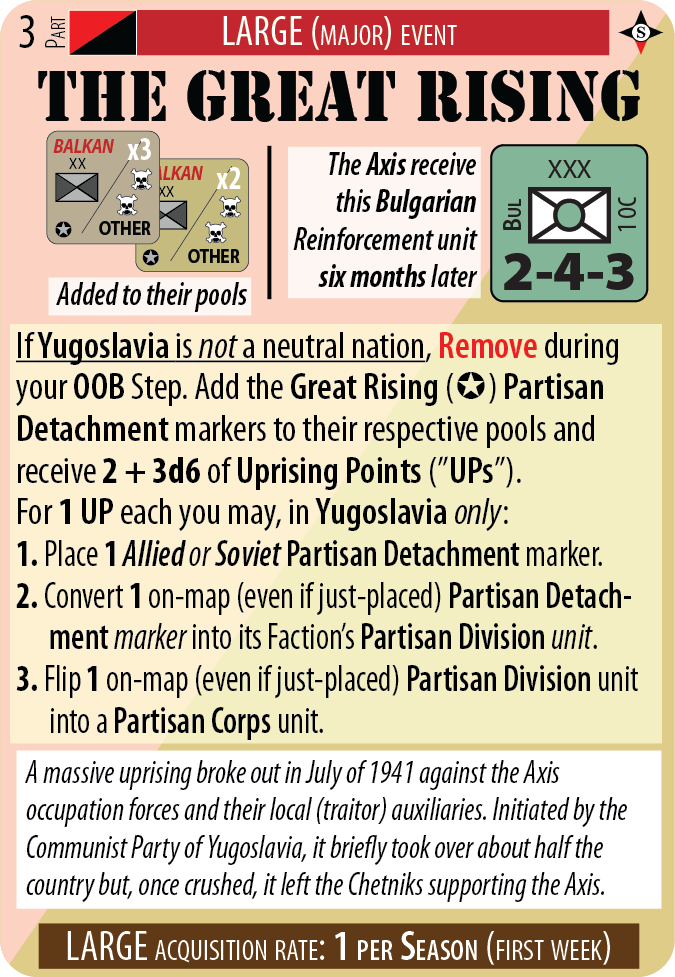



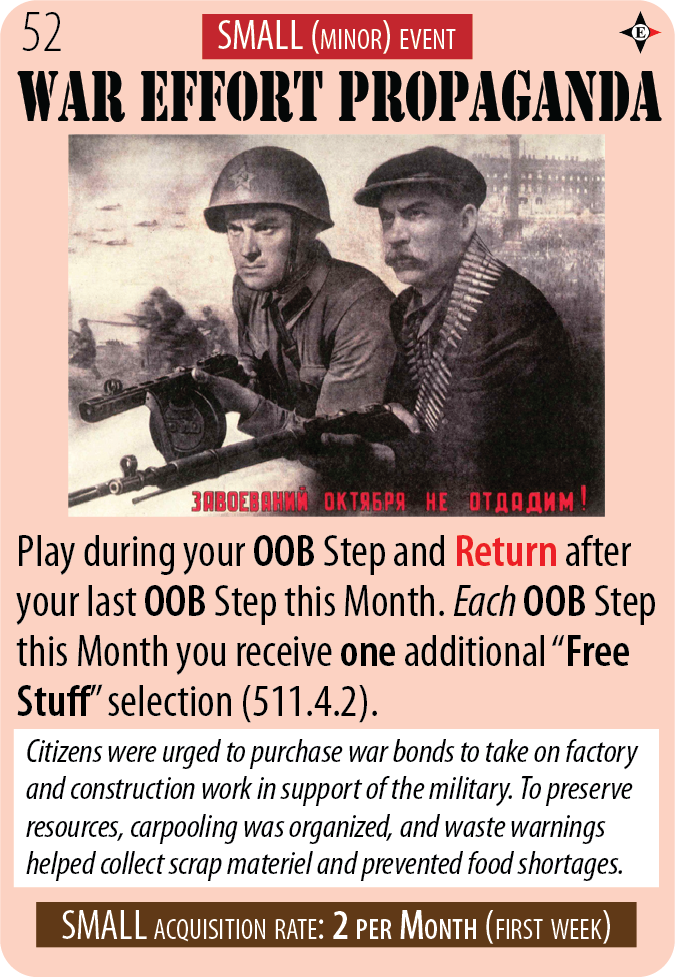

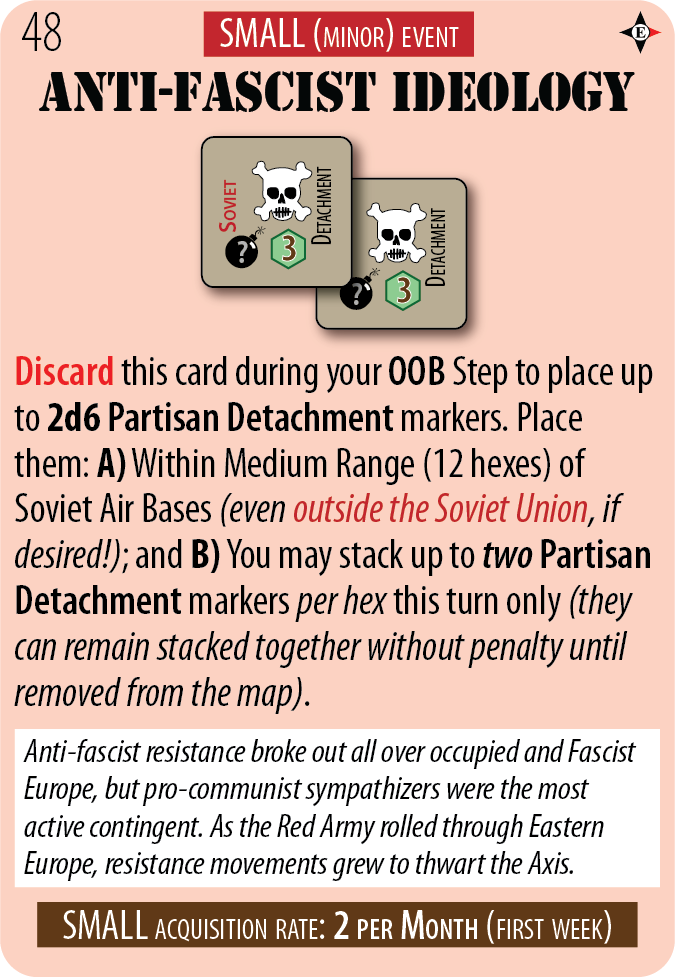





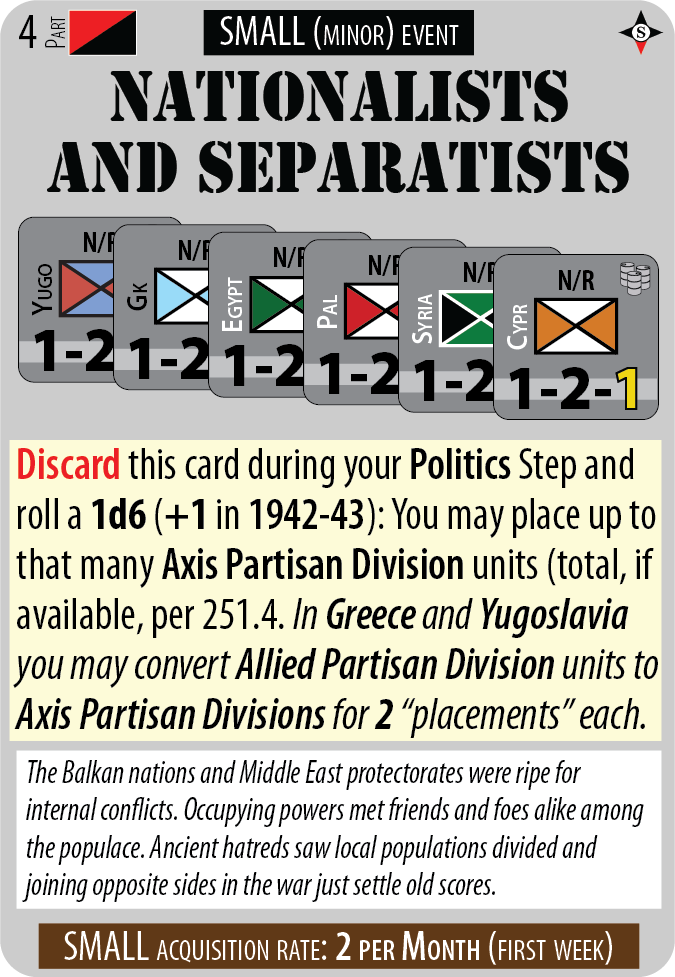

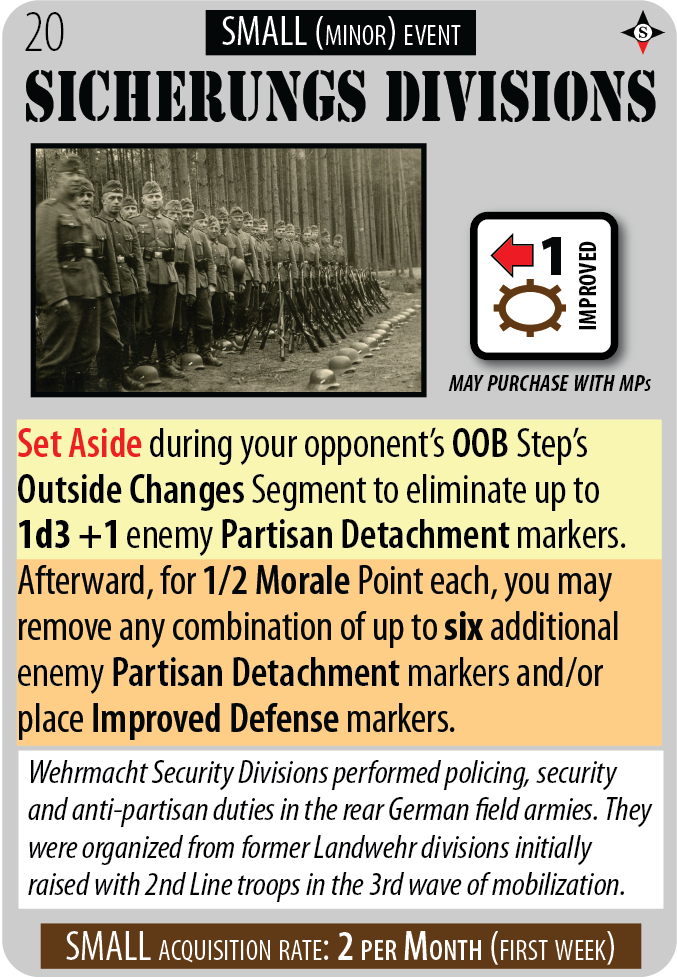

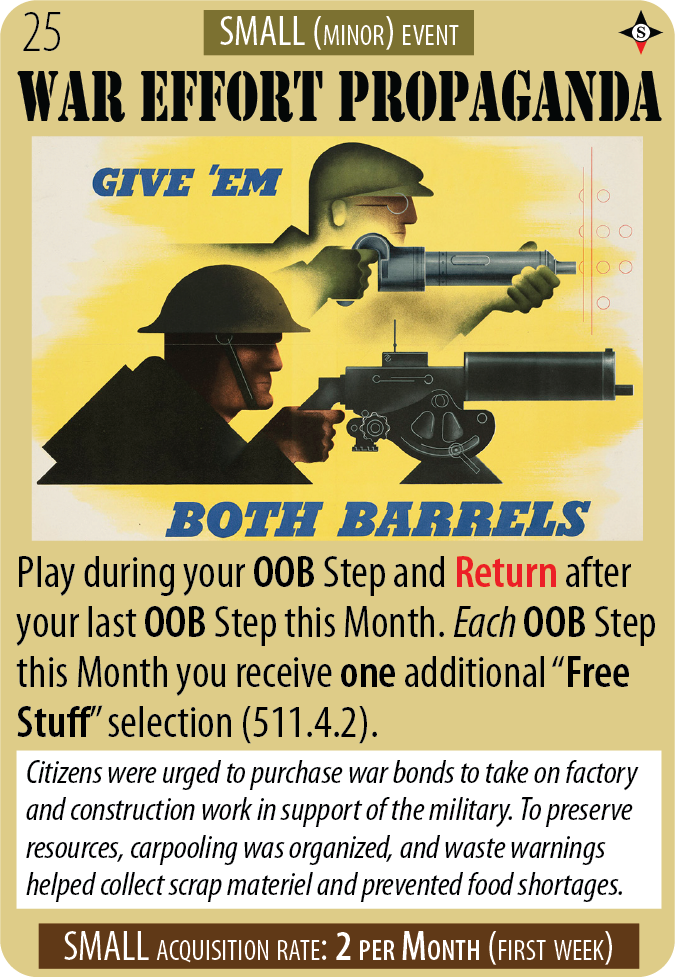

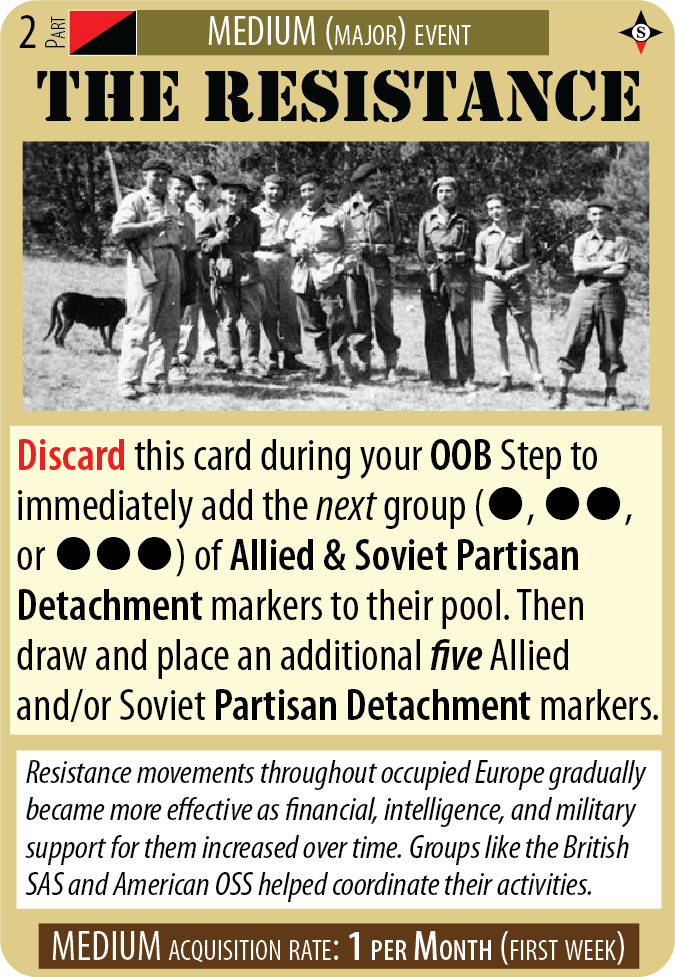

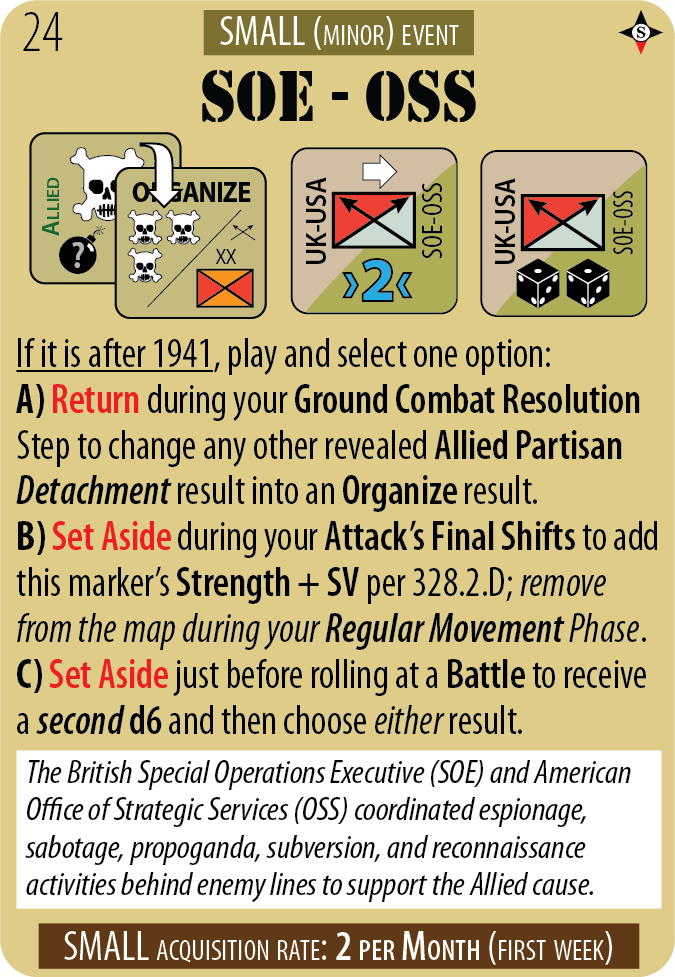



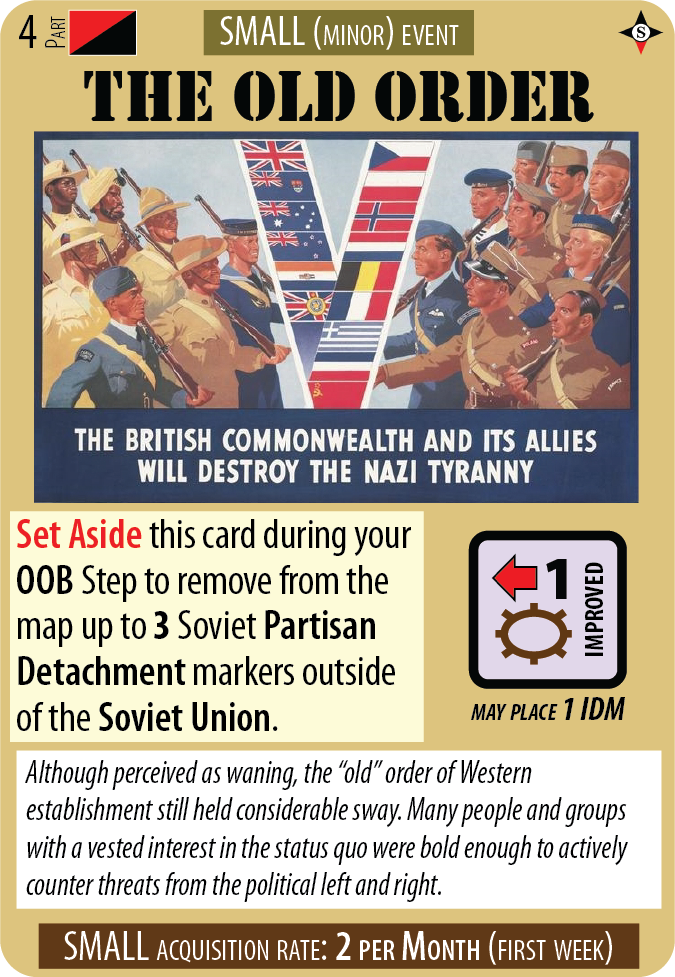




I have yet to experience the full potential of Partisans by playing a Campaign into '44, but there is a modest, colorful effect even in '41. My favorite is putting a Heavy Pz Corps OOS (better yet the rare Interdiction result), which can take away its White Bolt and seven Attack Factors.